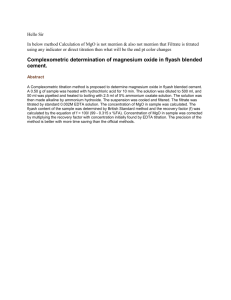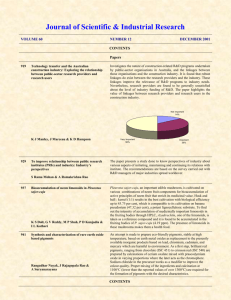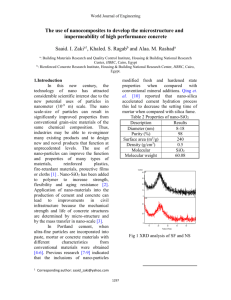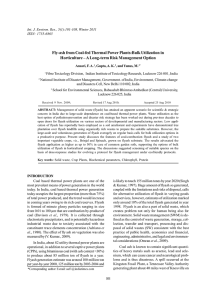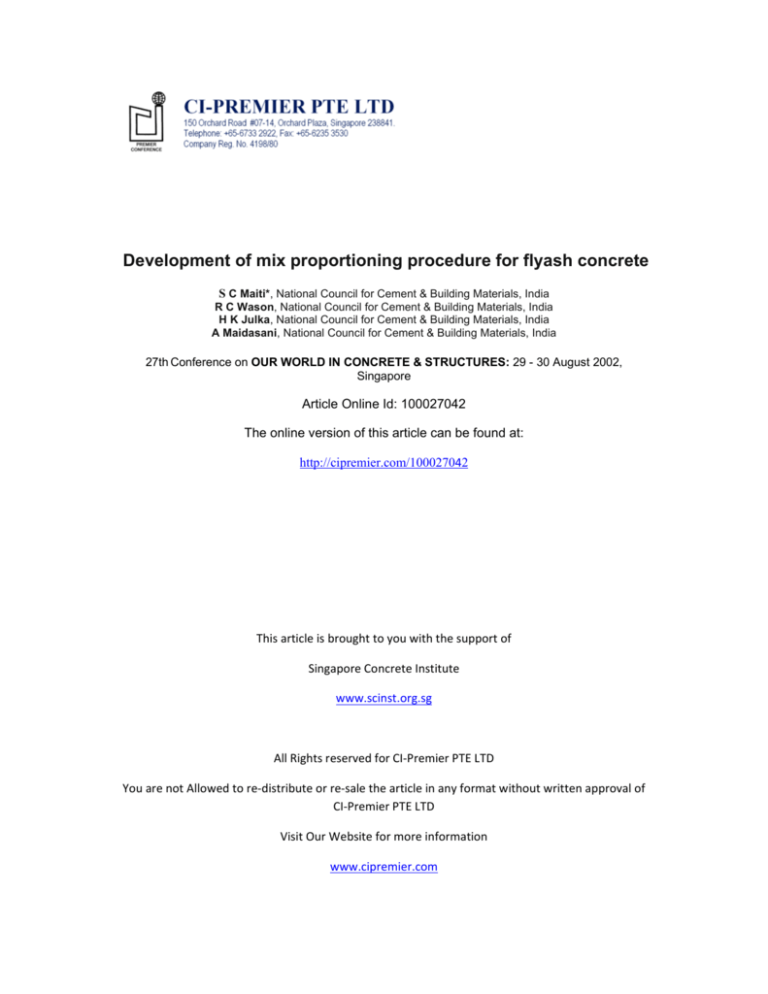
Development of mix proportioning procedure for flyash concrete
S C Maiti*, National Council for Cement & Building Materials, India
R C Wason, National Council for Cement & Building Materials, India
H K Julka, National Council for Cement & Building Materials, India
A Maidasani, National Council for Cement & Building Materials, India
27th Conference on OUR WORLD IN CONCRETE & STRUCTURES: 29 - 30 August 2002,
Singapore
Article Online Id: 100027042
The online version of this article can be found at:
http://cipremier.com/100027042
This article is brought to you with the support of Singapore Concrete Institute www.scinst.org.sg All Rights reserved for CI‐Premier PTE LTD You are not Allowed to re‐distribute or re‐sale the article in any format without written approval of CI‐Premier PTE LTD Visit Our Website for more information www.cipremier.com 2-rtr' Conference on OUR WORLD IN CONCRETE & STRUCTURES: 29 - 30 August 2002, Singapore
Development of mix proportioning procedure
for flyash concrete
5 C Maiti*, National Council for Cement & Building Materials, India R C Wason, National Council for Cement & Building Materials, India H K Julka, National Council for Cement & Building Materials, India A Maidasani, National Council for Cement & Building Materials, India Abstract
Presently, no mix proportioning procedure is available for the flyash concrete for the typical
Indian concrete-making materials and mix proportioning of flyash concrete is generally carried out by
trial and error. An R&D project has been taken up by Authors' organization to develop a dependable
mix proportioning procedure for such concretes.
The experimental work was carried out with two samples of ordinary Portland cement having
different strength levels. Relationships have been developed between water/cementitious materials
ratios and 28 days compressive strengths of concrete for different flyash contents in the mixes.
Taking relationship between water/cementitious materials ratio and strength of concrete as a
starting pOint of the procedure, the remaining steps of the mix design procedure have been finalized.
The experiments are being further conducted with cement samples having different strengths and with
more flyash samples. The procedure is also being tried for proportioning of flyash mixes for
commercial concretes being supplied by an RMC plant in India to various construction sites.
Keywords: Mix proportioning, Flyash, Water/cementitious materials ratio, Concrete making materials.
1. Introduction
Flyash, which is produced by thermal power plants in large quantity as a waste material (about 90
million tonnes annually), is used as a mineral admixture in concrete to improve its strength and
durability characteristics. Presently, good quality of fly ash conforming to IS 3812[1] is available in most
of the modern thermal plants in India. In many Countries like USA, UK, Netherlands, Germany etc.
flyash is being used as mineral admixture for making good quality and durable concretes[2J.
Flyash is used in concrete not only for normal building constructions, but also in high strength
concretes for special structures like long span bridges, high rise structures, tunnels to achieve
durability in concrete and to avoid formation of microcrakes caused by excessive heat of hydration
produced due to large quantity of high grade cement required to be used for making high strength
concrete. In the fourth revision recently, IS:456-2000 the code of practice for plain and reinforced
concrete[3] has also included the use of flyash in concrete as part replacement of ordinary Portland
cement provided uniform blending with cement is ensured.
2. Need for Mix Proportioning Procedure for Flyash Concrete
The Indian Code, IS 10262[4] recommended a mix design procedure for concrete without chemical
and mineral admixtures However, no mix proportioning procedure is available for the flyash concrete
for the typical Indian concrete-making materials and mix proportioning of flyash concrete is generally
carried out by trial and error. Extensive research has been carried out to arrive at a proper method of
proportioning the flyash concrete mixes and to study the effect of flyash addition on the properties of
concrete. According to Smith[5] , the water cement ratio for flyash concrete was calculated on the basis
of the 'Cementing efficiency factor' for flyash. This factor depends on the curing period, strength of the
mix and the type of flyash . Cannon[6] suggested that the difference in the yield due to a lager volume
of cementitious material in the flyash mix should be balanced by reduction in sand content. Adoption of
329 this procedure changes the gradation of the original mix. The demand for water in such mixes
depended on the mix itself, increased in certain cases and decreased in others.
Lovewell and Washa[7] found that the flyash addition had to exceed the amount of cement
removed in order to achieve the same strength. Additional quantity of flyash needed depended on the
strength of the mix. Ghosh[8] prepared design charts suitable for design of flyash concrete. He found
that the constants in Abrams' equation changed with the ratio of flyash and cement. However, these
equations are not quantified. The design charts were prepared for various flyash contents and water
cementitious ratios. Many other researches [9, 10, 11] have carried out studies for developing a mix
design procedure for flyash concrete but still a need has been felt to develop a dependable mix design
procedure for such concretes. Building research establishment[12] gives procedure for designing
flyash mixes with the available quality of materials i.e. cement and flyash. This procedure provides for
estimation of w/c ratio corresponding to the target strength of concrete based on cementing efficiency
factor. However, it is not directly applicable for concrete mixes made with materials used in India.
3. Experimental Work
3.1 Materials used
Two types of ordinary Portland cement (OPC) i.e. 43 grade OPC conforming to IS:8112[13] and 53
grade OPC conforming to IS: 12269[14] are used and their physical and chemical characteristics are
given in Table 1. Crushed quartzite was used as coarse aggregate and the a pit sand known as
'Badarpur' sand conforming to grading zone II requirement as per IS 383-1970[15] was used as fine
aggregate. The flyash sample collected from Talchar super thermal power station was used for the
studies. The flyash sample conformed to the requirement of IS 3812 (Table 2).
3.2 Concrete Mixes
Four grades of concrete i.e. M15, M20, M25, and M30 were taken up for the experimental work. The
workability of 50 mm slump was chosen for all the concrete mixes. The amount of fly ash incorporated
in the mixes was 0, 15, 25, and 35 % as replacement by weight of cement. The water/cementitious
materials ratios in different mixes varied from 0.450 to 0.722. The water content in the mixes was
varied to arrive at the required workability for the different proportions of cement, flyash and
aggregates. The mix proportions adopted for the various mixes with 43 Grade OPC and 53 Grade
OPC are given in Table 3 and Table 4 respectively .
Table 1 Characteristics of Cement samples
Test Results
43 Grade
53 Grade
352.4
307.4
Characteristics
Fineness, m"/kg
Setting Time, min
Initial
Final
Compressive Strength, N/mm"
3 Days
7 Days
28 Days
87
152
105
195
23.0
28.9
53.8
35.3
47 .6
58.2
Table 2 Characteristics of Flyash sample
Characteristics
Silica, Si02, %
Loss on Ignition, %
Lime Reactivity, N/mmz
Fineness, m"/kg
Specific Gravity
Test Results
60
0.3
7.2
338
2.09
330
Table 3 Mix Proportions With 43 Grade OPC
Grade of
Concrete
M15
M20
M25
M30
Flyash
content
(% by wt.
of cement)
0
15
25
35
0
15
25
35
0
15
25
35
0
15
25
35
Cement
Content
(kg/m3)
270
229
203
176
312
265
233
202
342
291
257
222
375
319
281
244
Water
Content
(kg/m3)
Flyash
Content
(kg/m3)
195
191
187
183
195
190
185
180
195
191
187
183
195
191
187
182
0
41
68
95
0
47
79
110
0
51
86
120
0
56
94
131
Fine
aggregate
Content
(kg/m3)
697
686
676
667
630
618
609
601
612
600
590
580
594
580
571
562
1140
1145
1153
1163
1187
1186
1195
1204
1174
1176
1182
1178
1164
1165
1170
1177
Water/
cementitious
materials
ratio
0.722
0.707
0.690
0.678
0.625
0.609
0.593
0.577
0.570
0.558
0.547
0.535
0.520
0.509
0.499
0.485
Coarse
aggregate
Content
3
(kg/m )
1192
1196
1204
1210
1163
1174
1182
1182
1161
1164
1173
1175
1155
1156
1162
1169
Water/
cementitious
Materials
ratio
0.657
0.647
0.630
0.614
0.600
0.572
0.557
0.542
0.572
0.555
0.536
0.522
0.488
0.475
0.463
0.450
Coarse
aggregate
Content
(kg/m
3
)
Table 4 Mix Proportions With 53 Grade OPC
Grade of
Concrete
M15
M20
M25
M30
Flyash
content
(% by wt.
of cement)
0
15
25
35
0
15
25
35
0
15
25
35
0
15
25
35
Cement
Content
(kg/m3)
Water
Content
(kg/m3)
Flyash
Content
3
(kg/m )
295
251
221
192
332
282
249
216
364
309
273
237
400
340
300
260
194
191
186
181
199
190
185
180
208
202
195
190
195
190
185
180
0
44
74
103
0
50
83
116
0
55
91
127
0
60
100
140
Fine
aggregate
Content
3
(kg/m )
636
624
614
609
620
613
603
594
592
584
577
574
590
578
568
558
4. Test Results and discussion
The 7 and 28 days compressive strength tests were carried out for the different mixes and the 28 days
results are presented here in Table 5. The compressive strength results have been plotted against
water/cementitious materials ratio for different flyash contents in Fig 1 and Fig 2 for mixes with 43
grade OPC and 53 grade ope respectively . On perusal of Fig 1 and Fig 2, it is seen that there exists a
relationship between water/cementitious material ratio and 28 days strength of cement. It is also seen
that the relationship is dependant on two other factors i.e. fly ash content in the mix and the strength of
cement. Further trials have been taken up to check the validity of this relationship for various samples
of flyash and cement. However, the relationship has been found suitable for establishing a mix design
procedure for flyash concrete.
331
Table 5 28 days compressive strength test Results for different mixes
Grade of
Concrete
Flyash
content
(% by wt.
of cement)
M15
0
15
25
35
0
15
25
35
0
15
25
35
0
15
25
35
M20
M25
M30
With 43 Grade OPC
Waterl
Cementitious
Material ratio
0.722
0.707
0.690
0.678
0.625
0.609
0.593
0.577
0.570
0.558
0.547
0.535
0.520
0.509
0.499
0.485
...
28 days
compressive
strength (N/mm2)
21.4
19.5
17.9
16.7
28.2
26.1
24.8
22.7
32.7
29.5
28.2
26.4
37.1
35.6
32.8
30.7
ope
.........
"' . ­
L .. ''',
....
.~ EE 30
.......
....
"""".
......
'. ......... .. -. '- "­
.
.......
x.. . "
•
5. g 25
§Z
Waterl
Cementitious
Material ratio
0.657
0.647
0.630
0.614
0.600
0.572
0.557
0.542
0.572
0.555
0.536
0.522
0.488
0.475
0.463
0.450
28 days
compressive
strength (N/mm2)
17.9
16.2
15.1
14.2
23.1
20 .9
19.1
18.2
29.3
26.2
24.3
23.0
35.1
32.0
30.1
27.1
With 43 grade
40
Q)
35
> ..-..
Q)
With 53 Grade OPC
20
.'
O'E
~ C» 15
.,'.
'~"
......
'-"- .. ....
-"-.
.. '"'-...
-"~A
'" ~
c 10
<0(;)
I NS
"C
o +--------,--------~--------._------_,
0.4 0.5
0.6
0.7
Water-Cementitious ratio
1- .. -
0% - ..
--3i% -
.j, -
25% -
.)E -
35%
0.8
1
Fig. 1 : Design curve of free water/cementitious materials ratio vs
28 days compressive strength of concrete
332
With 53 grade OPC
40
35
5
O +---~----~----.---~----~---.----~
0.4
0.45
0.55
0.5
0.6
0.66
0.7
0.75
Wa1er-Cementilious ratio
1-" -
()'!/, -
.....
·15%·· .. • ·25%
-"*- 35% 1
Fig. 2 : Design curve of free water/cementitious materials ratio vs
28 days compressive strength of concrete
5. Proposed Method:
The proposed method for mix proportioning of flyash concrete is based on the design curve of
free water/cementitious materials ratio vs 28 days compressive strength of concrete for specified
flyash content and 28 day strength of cement.
The main steps of the proposed procedure are as follows:
1) Determination of free water/cementitious material ratio.
For a given target strength and percentage of flyash, determine the corresponding
water/cementitious materials ratio from Fig 1 or Fig 2 depending upon the 28 day
compressive strength of cement.
2) Determination of water and fine aggregate contents.
Based on the maximum size and type of coarse aggregate to be used and the required
level of workability, determine the water and fine aggregate contents.
3) Determination of cement and flyash contents Combining the results of step 1 and 2, determine the cement and flyash contents. 4) Determination of coarse and fine aggregate contents.
Determine the coarse and fine aggregate content by absolute volume method or any other
suitable method.
The procedure given in IS 10262 can be adopted for steps 2 to 4 above.
333
Acknowledgement.
The paper is published with the permission of Director General of National Council for Cement
and Building Materials. The Authors thankfully acknowledge the contribution of Shri Suresh Kumar and
other colleagues in the experimental work.
References.
[1] IS:3812-1981, Specification for flyash for use as pozzolana and admixture, Bureau of Indian
Standards, New Delhi, 1981.
[2] Jain N.K. and Mohan K., Flyash as mineral admixture for high performance concrete , Fifth
International conference on concrete technology for developing countries, vol .1, 1999
[3] IS:456-2000 , Code of practice for plain and reinforced concrete, Bureau of Indian Standards,
New Delhi, 2000.
[4] IS:10262-1982; Recommended guidelines for concrete mix design , Bureau of Indian
Standards, New Delhi , 1982.
[5] Smith I.A., The design of flyash concrete, Proceedings, Institution of civil engineers (London) ,
vo1.36, 1967, pp 769-790.
[6] Cannon R.W., Proportioning flyash concrete mixes for strength and economy, ACI journal,
proceedings, vol .65, nO .11, 1968, pp 969-979.
[7] Lovewell C.E. and Washa G.W., Proportioning concrete mixtures using flyash, ACI journal,
proceedings, vol.54 no.12 July 1958, pp 1093-1102.
[8] Ghosh R.S ., Proportioning concrete mixes incorporating flyash, Canadian journal of civil
engineering (Ottawa) , vol.3 , 1976, pp 68-82
[9] Maiti S.C. and Jain N.K., Mix proportioning of superplasticized flyash concrete, Fifth
International conference on concrete technology for developing countries, vol.2, 1999
[101
Kumar V., Nautiyal B.D., Singh A.P. and Mohammad S. , Mix design of flyash concrete, Fifth
NCB International seminar on cement and building materials, 1996.
[11 J
RB-1981 , Procedure for designing flyash concrete mixes, Cement research institute of India,
1981.
[12] Teychenne D.C. , Franklin R.E. and Emtroy H.C. , Design of Portland cemenUpfa mixes,
Building research establishment report, 1988, pp 33-37.
[131 IS:8112-1989, Specification for 43 grade ordinary Portland cement, Bureau of Indian
Standards, New Delhi , 1989.
[14] IS:12269-1987, SpeCification for 53 grade ordinary Portland cement, Bureau of Indian
Standards, New Delhi , 1987.
[15] IS:383-1970, Specification for coarse and fine aggregates from natural sources for concrete,
Bureau of Indian Standards, New Delhi, 1970.
334

